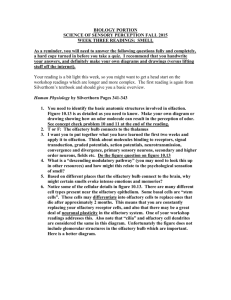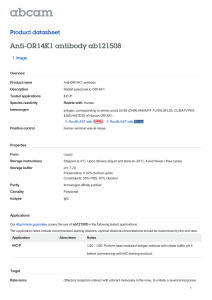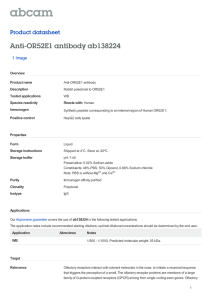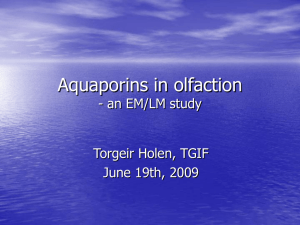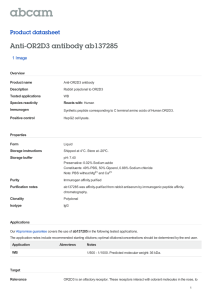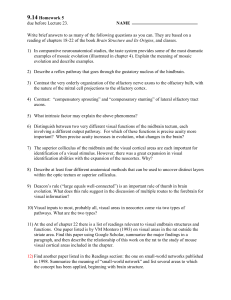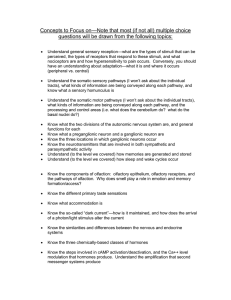OLFACTORY INTERACTION (draft) Ricardo Gutierrez
advertisement
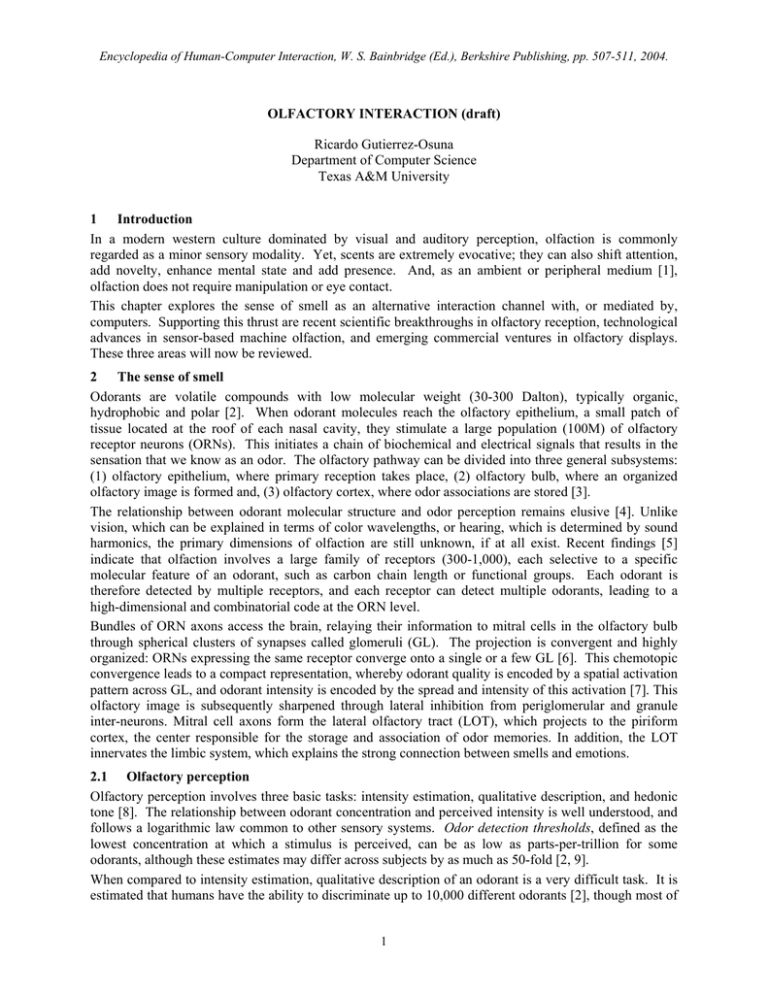
Encyclopedia of Human-Computer Interaction, W. S. Bainbridge (Ed.), Berkshire Publishing, pp. 507-511, 2004. OLFACTORY INTERACTION (draft) Ricardo Gutierrez-Osuna Department of Computer Science Texas A&M University 1 Introduction In a modern western culture dominated by visual and auditory perception, olfaction is commonly regarded as a minor sensory modality. Yet, scents are extremely evocative; they can also shift attention, add novelty, enhance mental state and add presence. And, as an ambient or peripheral medium [1], olfaction does not require manipulation or eye contact. This chapter explores the sense of smell as an alternative interaction channel with, or mediated by, computers. Supporting this thrust are recent scientific breakthroughs in olfactory reception, technological advances in sensor-based machine olfaction, and emerging commercial ventures in olfactory displays. These three areas will now be reviewed. 2 The sense of smell Odorants are volatile compounds with low molecular weight (30-300 Dalton), typically organic, hydrophobic and polar [2]. When odorant molecules reach the olfactory epithelium, a small patch of tissue located at the roof of each nasal cavity, they stimulate a large population (100M) of olfactory receptor neurons (ORNs). This initiates a chain of biochemical and electrical signals that results in the sensation that we know as an odor. The olfactory pathway can be divided into three general subsystems: (1) olfactory epithelium, where primary reception takes place, (2) olfactory bulb, where an organized olfactory image is formed and, (3) olfactory cortex, where odor associations are stored [3]. The relationship between odorant molecular structure and odor perception remains elusive [4]. Unlike vision, which can be explained in terms of color wavelengths, or hearing, which is determined by sound harmonics, the primary dimensions of olfaction are still unknown, if at all exist. Recent findings [5] indicate that olfaction involves a large family of receptors (300-1,000), each selective to a specific molecular feature of an odorant, such as carbon chain length or functional groups. Each odorant is therefore detected by multiple receptors, and each receptor can detect multiple odorants, leading to a high-dimensional and combinatorial code at the ORN level. Bundles of ORN axons access the brain, relaying their information to mitral cells in the olfactory bulb through spherical clusters of synapses called glomeruli (GL). The projection is convergent and highly organized: ORNs expressing the same receptor converge onto a single or a few GL [6]. This chemotopic convergence leads to a compact representation, whereby odorant quality is encoded by a spatial activation pattern across GL, and odorant intensity is encoded by the spread and intensity of this activation [7]. This olfactory image is subsequently sharpened through lateral inhibition from periglomerular and granule inter-neurons. Mitral cell axons form the lateral olfactory tract (LOT), which projects to the piriform cortex, the center responsible for the storage and association of odor memories. In addition, the LOT innervates the limbic system, which explains the strong connection between smells and emotions. 2.1 Olfactory perception Olfactory perception involves three basic tasks: intensity estimation, qualitative description, and hedonic tone [8]. The relationship between odorant concentration and perceived intensity is well understood, and follows a logarithmic law common to other sensory systems. Odor detection thresholds, defined as the lowest concentration at which a stimulus is perceived, can be as low as parts-per-trillion for some odorants, although these estimates may differ across subjects by as much as 50-fold [2, 9]. When compared to intensity estimation, qualitative description of an odorant is a very difficult task. It is estimated that humans have the ability to discriminate up to 10,000 different odorants [2], though most of 1 Encyclopedia of Human-Computer Interaction, W. S. Bainbridge (Ed.), Berkshire Publishing, pp. 507-511, 2004. us only experience a fraction of these in our lifetime. Various schemes, such as Henning’s odor prism (flowery, putrid, fruity, spicy, burned and resinous), have been proposed in the past in an attempt to classify odors into a small number of dimensions [9, 1]. Due to the lack of success of these efforts, current approaches employ odor profiling techniques, in which a large number of verbal descriptors are used to describe individual odors [8, 2]. The hedonic tone is a qualitative property related to the pleasantness of an odorant. The hedonic quality is highly subjective, and is influenced by cultural factors and emotional associations [10]. In addition, hedonic tone is non-monotonically dependent on the exposure levels: some odorants are pleasant at low concentration but not at high (or persistent) doses. The hedonic tone of an odor is not hardwired in the brain, but shaped through experience; whether a subject likes an odor or not depends largely on the associations made through life. Recent work by Herz [11] indicates that, contrary to popular belief, odorants are not more effective than other sensory stimuli at recalling purely factual information. Instead, smell-related memories have a stronger emotional content than those triggered by other sensory modalities. Information processing by ORNs and the bulb suggest that olfaction is an analytical sense, whereby odorants are meticulously broken down into their constituent molecular determinants. Interestingly, the view that emerges from psychophysics is that olfaction is in fact synthetic or holistic: odors are perceived as irreducible entities [10]. Although the ability to discriminate and verbally describe odors increases with experience (e.g., wine tasters), humans are unable to segment individual odorants from mixtures with three or more components, regardless of prior experience or training. 3 Sensor based machine olfaction Machine olfaction with chemical sensor arrays has been a fertile research area during the past two decades [12]. Commonly referred to as “electronic noses”, SBMO instruments employ arrays of crossselective chemical sensors coupled with pattern recognition algorithms to detect and identify complex odorants. SBMO represents a fast and inexpensive odor measurement alternative to analytical approaches, such as gas chromatography-mass spectrometry (GC-MS), or sensory analysis with human panels. A variety of odor sensing technologies have been used, the most popular being resistive and piezoelectric devices. In chemoresistive sensors the presence of volatile organic compounds (VOCs) changes the resistance of a chemically-sensitive material, typically a metal-oxide or a conducting polymer. Piezoelectric sensors are mass-sensitive devices; absorption of VOCs increases the mass of a sensing membrane, which results in changes in phase or resonant frequency of a piezoelectric substrate. Additional odor sensing technologies include field-effect and optical devices [13, 14]. Pattern recognition for SBMO follows the general principles for processing multivariate data. First, raw sensor signals are preprocessed for noise reduction and normalization purposes. A number of descriptive features are then identified in the sensor signals using domain knowledge, and compressed onto a few dimensions through feature extraction/selection. Finally, a pattern-recognition model is trained to predict a property of the odorant: its identity, the concentration of its constituents in the case of a mixture, or how the odor may be perceived by humans. The latter is arguably the ultimate goal of SBMO [15]. The most unique and challenging computational aspects of SMBO are in the early stages of processing. In particular, odor sensors are subject to long-term drift, which causes previously learned odor patterns to become obsolete over time. This requires drift-compensation algorithms combined with periodic recalibration [16]. 3.2 Outlook During their first two decades of existence, commercial “electronic noses” were marketed as generalpurpose instruments that could be customized to any application by simply training their patternrecognition engines on the odorant samples of interest. Experience has shown that this is not possible – not with current chemical sensors. As a result, commercial efforts are moving towards application- 2 Encyclopedia of Human-Computer Interaction, W. S. Bainbridge (Ed.), Berkshire Publishing, pp. 507-511, 2004. specific chemical sensor systems. However, true machine olfaction, as opposed to chemical sensing, implies predicting the perceptual properties of an odorant from the sensor-array response. Prediction of perceived intensity is relatively straightforward since both chemical sensors and ORNs have monotonic concentration-response curves. Unfortunately, correlation with perceived quality, hedonic tone or organoleptic descriptors is a more challenging problem. These will require developing sensing materials capable of detecting the stereo-chemical properties of odorant molecules which, until a complete understanding of primary reception is available, are the best known determinants of odor quality [17, 18]. Correlations between sensor-array responses and sensory analysis ratings have been demonstrated on a few quality-control applications [19, 20], but prediction of organoleptic properties has been moderately successful to date [21]. 4 Olfactory displays Whereas SBMO is concerned with generating a digital representation of an odorant, olfactory displays (ODs) are concerned with the complementary problem: synthesizing odorants from a digital description. In its most general form, an OD consists of a palette of odorants, a flow delivery system and a control algorithm that determines the mixing ratios, concentration and timing of the stimulus. Odorants can be stored in the liquid phase and released using inkjet printer technology, or micro-encapsulated, as in the “scratch-n-sniff” cards, and released thermally or mechanically [1, 8]. Once released, odorants may be dispersed using a general air ventilation system, or delivered locally with a whiffer [8] or head-mounted gear [22]. Why olfactory displays? ODs have been shown to enhance the sense of presence and add salient spatial cues in virtual reality (VR) environments [23, 24]. Along these lines, ODs have been used to enhance VR-based training systems for firefighters and emergency medical personnel [22, 25]. The reader is referred to [26] for a detailed discussion of ODs in VR. ODs also have broad commercial applications in high-end gaming and virtual shopping malls [1]. Coupled with SBMO, ODs may be used to digitally transmit olfactory stimuli [27]. To this end, Yamanaka et al. [28] have recently developed a system capable of digitizing fruit odors and synthesizing mockups using a palette of odorants and a sensor array. A critical point for tele-olfaction is the construction of a mapping from sensor-array data (or odorant mixtures) onto olfactory perception [8], which is challenging with current chemical sensors (or current understanding of mixture perception.) Simpler domains that bypass the odor digitization/synthesis problem have been proposed by Kaye [1], who views olfactory cues as iconic representations. These odor cues may be semantically related to the represented object, such as the smell of burnt rubber in a car-racing VR game, or they could be related only in an abstract manner, such as using a puff of scent to remind the user to attend a meeting. Using very simple devices, this work raises interesting questions about the use of ODs in computer-mediated interaction. Finally, ODs may also be used as therapeutic devices, as exemplified by the field of aroma-chology. For instance, vanilla fragrances reduce anxiety [29], peppermint scents increase job performance [30, 31], and cinnamon scents improve creative problem solving [32]. More interestingly, specific odor-state associations may be built through training; Schiffman [33] has shown that people can be trained to relax in the presence of a pleasant odor, so that the same state of relaxation can be induced at a later time by presentation of the odor alone. Future affective interfaces [34] may be able to predict psychological state from physiological signals (e.g., heart and respiration rates, electrodermal activity), and release a suitable fragrance in response. 4.1 Outlook A number of companies (e.g., DigiScents, TriSenx, AromaJet, OlfaCom) have recently advertised consumer-grade ODs, though at the time of this writing none of these efforts have lead to a tangible product. Leaving aside economic or strategic issues that may have prevented these designs from reaching the production line, ODs face several scientific and technological challenges. The most fundamental 3 Encyclopedia of Human-Computer Interaction, W. S. Bainbridge (Ed.), Berkshire Publishing, pp. 507-511, 2004. issues derive from olfactory reception and psychophysics. A good understanding of the primary determinants of odor quality in single odorants and complex mixtures is required before perceptuallyaccurate stimuli can be generated from odorant palettes. The effects of various odorant delivery parameters (e.g., concentration, duration, frequency, flow rate) need to be thoroughly characterized [26, 1]. Careful attention must also be paid to the issue of hypersensitivity to scents. Finally, technological advances in odorant storage, delivery and removal are also required, though olfactory stimuli will remain inherently more involved than audio-visual media. 5 Summary This article has presented an introduction to olfactory interfaces: sensor based machine olfaction and olfactory displays. The main characteristics, advantages, disadvantages and open problems of these two promising technologies are summarized in Table 1. Although the more challenging application domains will require a better understanding of olfactory reception and perception, research into computer-mediated iconic olfactory interaction is ready for prime time. Table 1. Summary of olfactory interfaces ELECTRONIC NOSES PROPERTIES STRENGTHS DRAWBACKS OPEN QUESTIONS OLFACTORY DISPLAYS • Distributed representation • Synthetic recognition • Iconic representation • Ambient media • Evocative • • • • • • • • • Objective odor measurement High throughput, on-line capabilities Low cost, portable Easy to operate Improved sense of presence Complementary, novelty cue Potent trigger for emotional memories Hands and eye-free Therapeutic • Cross-sensitivity to interferents • Odor quality may be determined by • Low bandwidth, as compared to vision odorants in trace-level concentrations • Not suited for chemical analysis • Subjectivity, cultural and individual • Improvements in sensor sensitivity, • Synthesis of perceptually-realistic • • • • • • selectivity, stability and reproducibility Sample preparation and delivery Drift compensation Background suppression Correlation with molecular determinants of odor quality Market development Odorant standards 4 and hearing differences • Hypersensitivity to scents • Adaptation, olfactory fatigue stimuli from odorant palettes • Psychophysics characterization of odorant delivery parameters • Technological improvements in odorant storage, delivery and removal • Market development • Odorant standards Encyclopedia of Human-Computer Interaction, W. S. Bainbridge (Ed.), Berkshire Publishing, pp. 507-511, 2004. 6 Acknowledgments This material is based upon work supported by NSF CAREER Grant No. 9984426/0229598. A. Perera, B. Raman and A. Gutierrez are gratefully acknowledged for their valuable comments on an earlier version of this manuscript. 7 Further reading Readers interested in pursuing these topics further are referred to Wilson and Stevenson [10], Pearce et al. [35], and Kaye [1]. 8 References [1] Kaye, J. N. (2001) Symbolic Olfactory Display. Master’s Thesis, MIT Media Lab. [2] Schiffman, S. S., & Pearce, T. C. (2003) Introduction to olfaction: perception, anatomy, physiology, and molecular biology. In T. C. Pearce, S. S. Schiffman, H. T. Nagle and J. W. Gardner (Eds.), Handbook of Machine Olfaction: Electronic Nose Technology, Wiley-VCH. [3] Pearce, T. C., (1997). Computational parallels between the biological olfactory pathway and its analogue `The Electronic Nose': Part I. Biological Olfaction. Biosystems, 41(2), 43-67. [4] Chastrette, M. (1997). Trends in structure-odor relationships. SAR and QSAR in Environmental Research 6, 215-254. [5] Buck, L. B. & Axel, R. (1991). A novel multigene family may encode odorant receptors: a molecular basis for odor recognition. Cell, 65, 175-187. [6] Malnic, B., Hirono, J., Sato, T., & Buck, L. B. (1999). Combinatorial receptor codes for odors. Cell, 96, 713-723. [7] Gutierrez-Osuna, R. (2002). A Self-organizing Model of Chemotopic Convergence for Olfactory Coding. Proc. 2nd Joint EMBS-BMES Conference, Houston, TX, 23-26 October 2002, vol.1, pp. 236-237. [8] Harel, D., Carmel, L., & Lancet, D. (2003). Towards an odor communication system. Computational Biology and Chemistry, 27, 121-133. [9] Engen, T. (1982). The Perception of Odors. Academic Press: New York. [10] Wilson, D. A., & Stevenson, R. J. (in press). Olfactory perceptual learning: the critical role of memory in odor discrimination. Neuroscience and Biobehavioral Reviews. [11] Herz, R. S. (1998). Are odors the best cues to memory? A cross-modal comparison of associative memory stimuli. Annals of the New York Academy of Sciences, 855, 670-674. [12] Persaud, K. C., & Dodd, G. H. (1982). Analysis of discrimination mechanisms of the mammalian olfactory system using a model nose. Nature, 299, 352-355. [13] Gardner, J. W., & Bartlett, P. N., Electronic noses. Principles and Applications. Oxford University Press: New York. [14] Nagle, H. T., Schiffman, S. S., & Gutierrez-Osuna, R. (1998). The how and why of electronic noses. IEEE Spectrum, September 1998, 22-34. [15] Gutierrez-Osuna, R. (2002). Pattern Analysis for Machine Olfaction: A Review. IEEE Sensors Journal, 2(3), 189-202. [16] Holmberg, M., & Artursson, T. (2003). Drift Compensation, Standards, and Calibration Methods. In T. C. Pearce, S. S. Schiffman, H. T. Nagle and J. W. Gardner (Eds.), Handbook of Machine Olfaction: Electronic Nose Technology, Wiley-VCH, 325-346. [17] Pearce, T. C. (1997). Computational parallels between the biological olfactory pathway and its analogue ‘The Electronic Nose’: Part II. Sensor-based machine olfaction. BioSystems, 41, 69–90. 5 Encyclopedia of Human-Computer Interaction, W. S. Bainbridge (Ed.), Berkshire Publishing, pp. 507-511, 2004. [18] [19] [20] [21] [22] [23] [24] [25] [26] [27] [28] [29] [30] [31] [32] [33] [34] [35] Pelosi, P., & Persaud, K. C. (2000). Physiological and Artificial Systems for Odour Recognition. In F.Mazzei and R.Pilloton (Eds.), Proc. 2nd Italian Workshop on Chemical Sensors and Biosensors, Rome, Italy, March 18-19, 2000, 37-55. Sneath, R. W., & Persaud, K. C. (2003). Correlating Electronic Nose and Sensory Panel Data. In T. C. Pearce, S. S. Schiffman, H. T. Nagle and J. W. Gardner (Eds.), Handbook of Machine Olfaction: Electronic Nose Technology, Wiley-VCH, 377-397. Nagle, H. T., Gutierrez-Osuna, R., Kermani, B. G., & Schiffman, S. S. (2003). Environmental Monitoring. In T. C. Pearce, S. S. Schiffman, H. T. Nagle and J. W. Gardner (Eds.), Handbook of Machine Olfaction: Electronic Nose Technology, Wiley-VCH, 419-444. Burl, M. C., Doleman, B. J., Schaffer, A., & Lewis, N. S. (2001). Assessing the ability to predict human percepts of odor quality from the detector responses of a conducting polymer compositebased electronic nose. Sensors and Actuators B: Chemical 72(2), 149-159. Cater, J. P. (1994). Approximating the senses. Smell/taste: Odors in Virtual Reality. In Proc. IEEE Int. Conf. Systems, Man and Cybernetics, San Antonio, TX, Oct. 2-5, 1994, 1781. Tominaga, K., Honda, S., Ohsawa, T., Shigeno, H., Okada, K., & Matsushita, Y. (2001). Friend Park. Expression of the Wind and the Scent on Virtual Space. In Proc. 7th Int. Conf. Virtual Systems and Multimedia, Berkeley, CA, Oct. 25-27, 2001, 507 -515. Dinh, H. Q., Walker, N., Song, C., Kobayashi, A., & Hodges, L. F. (1999). Evaluating the Importance of Multi-sensory Input on Memory and the Sense of Presence in Virtual Environments. In Proc. IEEE Virtual Reality, Houston, TX, March 13-17, 1999, 222-228. Krueger, M. W. (1995). Olfactory Stimuli in Virtual Reality for Medical Applications. In K. Morgan, R. M. Satava, H. B. Sieburg et al. (Eds.), Interactive Technology and the New Paradigm for Healthcare, Amsterdam: IOS Press, 180-181. Barfield, W., & Danas, E. (1996). Comments on the Use of Olfactory Displays for Virtual Environments. Presence, 5(1), 109-121. Keller, P. E., Kouzes, R. T., Kangas, L. J., & Hashem, S. (1995). Transmission of Olfactory Information for Telemedicine. in K. Morgan, R.M. Satava, H.B. Sieburg, R. Matteus, and J.P. Christensen, (Eds.), Interactive Technology and the New Paradigm for Healthcare, IOS Press and Ohmsha, Amsterdam, 168-172. Yamanaka, T., Matsumoto, R., & Nakamoto, T. (2003). Study of recording apple flavor using odor recorder with five components. Sensors and Actuators B: Chemical, 89(1-2), 112-119. Redd, W., & Manne, S. (1995). Using Aroma to Reduce Distress During Magnetic Resonance Imaging. In A. Gilbert (ed.), Compendium of Olfactory Research 1982-1994, Dubuque, Iowa: Kendall/Hunt Publishing Co., 47-52. Warm, J. S., Dember, W.N., & Parasuraman, E. (1992). Effects of Olfactory Stimulation on Performance and Stress in a Visual Sustained Attention Task. Journal of the Society of Cosmetic Chemists, 42, 199-210. Sullivan, T. E., Warm, J. S., Schefft, B. K., Dember, W. N., O'Dell, M. W., & Peterson, S. J. (1998). Effects of Olfactory Stimulation on the Vigilance Performance of Individuals with Brain Injury. Journal of Clinical and Experimental Neuropsychology, 20(2), 227-236. Isen, A. M., Ashby, F. G., & Waldron, E. (1997). The Sweet Smell of Success. The AromaChology Review, 4(3), 1. Schiffman, S. S. (1995). Use of olfaction as an alarm mechanism to arouse and alert sleeping individuals. Aroma-Chology Review, 4(1), 2-5. Picard, R. W. (1997). Affective Computing, Cambridge, MIT Press. T. C. Pearce, S. S. Schiffman, H. T. Nagle and J. W. Gardner (Eds.), Handbook of Machine Olfaction: Electronic Nose Technology, Wiley-VCH. 6
